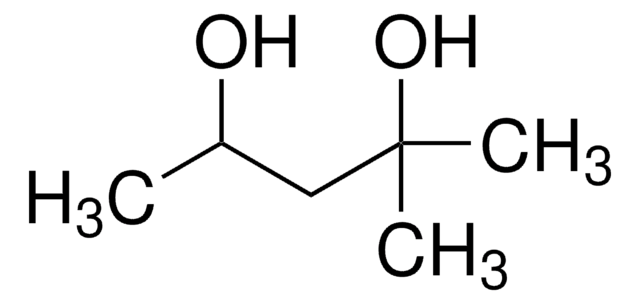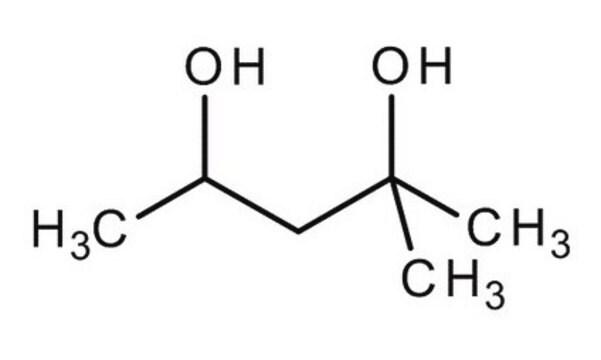112100
Hexylene glycol
99%
Synonyme(s) :
(±)-2-Methyl-2,4-pentanediol, MPD
About This Item
Produits recommandés
Densité de vapeur
4.1 (vs air)
Niveau de qualité
Pression de vapeur
0.02 mmHg ( 20 °C)
Essai
99%
Forme
liquid
Limite d'explosivité
7.4 %
Indice de réfraction
n20/D 1.427 (lit.)
pb
197 °C (lit.)
Pf
−40 °C (lit.)
Densité
0.925 g/mL at 25 °C (lit.)
Groupe fonctionnel
hydroxyl
Chaîne SMILES
CC(O)CC(C)(C)O
InChI
1S/C6H14O2/c1-5(7)4-6(2,3)8/h5,7-8H,4H2,1-3H3
Clé InChI
SVTBMSDMJJWYQN-UHFFFAOYSA-N
Vous recherchez des produits similaires ? Visite Guide de comparaison des produits
Catégories apparentées
Description générale
Application
- pH regulatory divergent point for the selective bio-oxidation of primary diols during resting cell catalysis.: This study highlights the role of Hexylene Glycol in biocatalysis, emphasizing its application in enhancing the selective oxidation of primary diols, which is pivotal for developing efficient bio-based production processes (Hua et al., 2022).
Mention d'avertissement
Warning
Mentions de danger
Conseils de prudence
Classification des risques
Eye Irrit. 2 - Repr. 2 - Skin Irrit. 2
Code de la classe de stockage
10 - Combustible liquids
Classe de danger pour l'eau (WGK)
WGK 1
Point d'éclair (°F)
201.2 °F - closed cup
Point d'éclair (°C)
94 °C - closed cup
Équipement de protection individuelle
Eyeshields, Gloves, type ABEK (EN14387) respirator filter
Faites votre choix parmi les versions les plus récentes :
Déjà en possession de ce produit ?
Retrouvez la documentation relative aux produits que vous avez récemment achetés dans la Bibliothèque de documents.
Les clients ont également consulté
Notre équipe de scientifiques dispose d'une expérience dans tous les secteurs de la recherche, notamment en sciences de la vie, science des matériaux, synthèse chimique, chromatographie, analyse et dans de nombreux autres domaines..
Contacter notre Service technique






